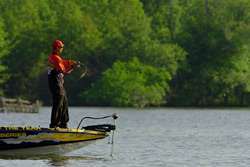
It's the final stage of postspawn. The bass have migrated from spawning flats and shallow coves to mainlake points, ledges and dropoffs, where they will form schools and remain for the summer.
Meanwhile, another spawn is underway and it's undeniably the most underrated scenario in springtime bass fishing. It is an angling opportunity that can pay the biggest dividends in postspawn and best of all, it's a no-brainer to master.
Kevin VanDam added an exclamation point to the relatively unknown technique after posting his 11th BASS win April 29 on Lake Guntersville. After four days of fishing on the powerhouse impoundment, KVD racked up a winning weight of 66 pounds, 3 ounces, in a technique that revolved around the spawning of the lake's shad population. His final-day catch of more than 25 pounds included a 7-pound kicker that iced the win.
"The shad spawn kicks the bass' metabolism into high gear," he notes. "Shad are a great food source and it's a great opportunity for an angler to capitalize on their spawn."
Chris Horton, BASS Conservation director and a professional fisheries biologist, explains how the shad spawn equates to bass fishing success.
"Shad spawn in schools and their eggs are demersal (fall to the bottom) and adhesive, sticking to grass or rocks, and left unguarded," he says. "They don't spawn out in open water, but not as shallow as bass or bluegill."
From a bass fishing perspective, VanDam finds the best time to leverage the spawn is in low light situations.
"The early morning bite is critical," he says. "From my experience much of the spawn occurs at night, making the early morning hours before the sun comes up a key time to be on the water. And the shad are easier to visually locate then."
VanDam begins his search for the shad by looking for telltale signs of their presence, such as birds feeding on the newly hatched fry. Or even better, the surface erupting from a bass feeding frenzy. Otherwise, he'll search for spawning areas that hold the most potential for attracting bass.
"These baitfish will relate to some type of habitat, not unlike bass. They are seeking out cover to hide from predators such as bass," he explains. "The ideal scenario, and what I found on Guntersville, is to find a combination of postspawn bass habitat and shad spawning area."
The combination that paved the way for VanDam's success came in the form of mixed varieties of aquatic vegetation growing on main river channel ledges and breaklines. The textbook combination of depth, cover and food polarized the bass to the habitat targeted by VanDam.
Honing in on the shad is the easy part, says VanDam.
"The best method for confirming the presence of shad and their fry is by throwing a double willowleaf spinnerbait into the cover. Matching the blade size to the composition of the baitfish is critical."
"If the shad get active, then the bass get active," he says. "If they get nervous and start following your bait, the bass are sure take a look at it."
Not unlike bass, water temperature is the biological key to the shad spawn. Generally, shad will spawn when surface temperatures reach the upper 60s and lower 70s.
"The key is that shad will be active in the morning and that in turn will fire up the bass," concludes VanDam. "You can't beat that action and it's just a great time to be on the water."





